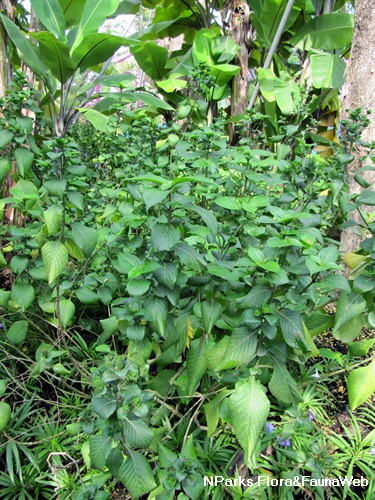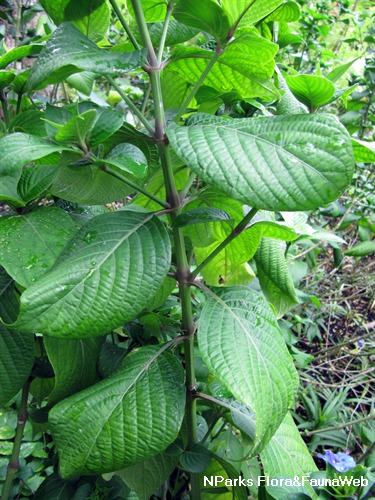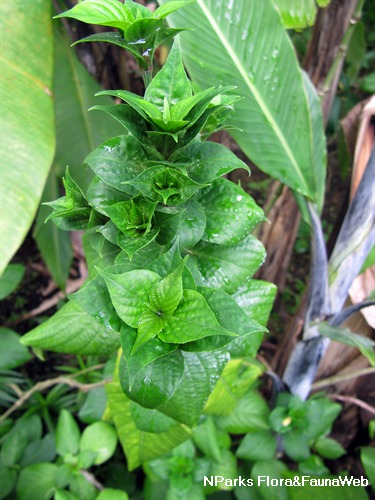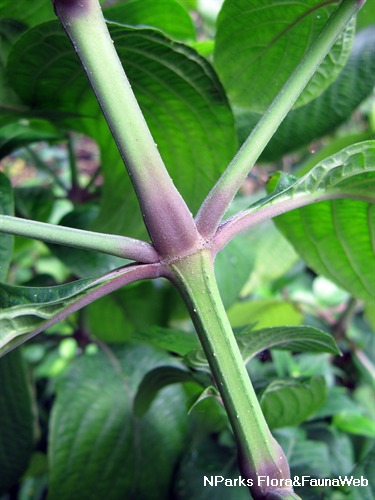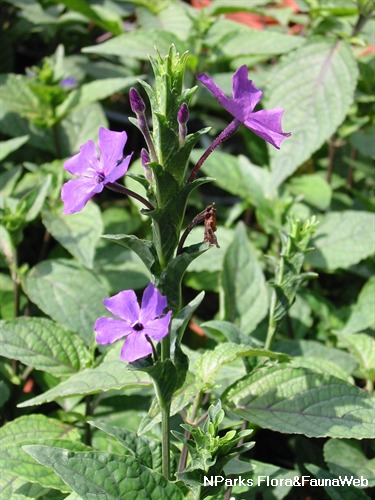
Back
Eranthemum pulchellum Hort.
| Family Name: | Acanthaceae |
| Synonyms: | Eranthemum nervosum |
| Common Name: | Blue Sage |
Blue Sage (Eranthemum pulchellum) is an evergreen shrub with attractive blue flowers and large prominently veined leaves. This plant is ideal as a specimen plant or grown in containers on garden patios.
Name
Classifications and Characteristics
| Plant Division | Angiosperms (Flowering Seed Plants) |
|---|---|
| Plant Growth Form | Shrub |
| Lifespan (in Singapore) | Perennial |
| Mode of Nutrition | Autotrophic |
| Plant Shape | Shrubby |
| Maximum Height | 1.2 m to 1.8 m |
| Maximum Plant Spread / Crown Width | 0.3 m to 0.9 m |
Biogeography
| Native Distribution | Indian Subcontinent, Laos, Myanmar, Thailand, Vietnam. |
|---|---|
| Native Habitat | Terrestrial |
| Preferred Climate Zone | Tropical, Sub-Tropical / Monsoonal |
| Local Conservation Status | Non-native |
Description and Ethnobotany
| Growth Form | Sprawling sub-shrub growing in an upright-open form between 1.2 to 1.8 m tall and 0.3 - 0.9 m wide. |
|---|---|
| Foliage | Hairy leaves, dark green, elliptic and large in size, simple and opposite, measuring about 10 cm long. |
| Flowers | Blue flowers, trumpet-sized, terminal spikes measuring about 15 cm long. |
| Fruit | Fruit is oval in shape, brown in colour and measuring about 1.2 cm. |
| Cultivation | Blue Sage prefers fertile, well-drained soils. It grows well in the area where it receives filtered sunlight or semi-shade. Remove spent flowers to induce more blooming. |
| Etymology | Genus Eranthemum means Love-flower. Species pulchellum means beautiful. |
Landscaping Features
| Desirable Plant Features | Ornamental Flowers |
|---|---|
| Landscape Uses | Parks & Gardens, Small Gardens |
Plant Care and Propagation
| Light Preference | Full Sun, Semi-Shade |
|---|---|
| Water Preference | Moderate Water |
| Plant Growth Rate | Fast |
| Rootzone Tolerance | Moist Soils, Well-Drained Soils, Fertile Loamy Soils, Acidic (low pH) Soils |
| Maintenance Requirements | Moderate |
| Pruning | Will produce more blooms and remain compact if plant is severely cut back after flowering. |
| Potential Problems | Scale bugs, mealy bugs and nematodes may appear. |
| Diseases | No serious disease problems. |
| Propagation Method | Stem Cutting (Softwood) |
| Propagation Method Remarks | Softwood cuttings are prepared from stems that can still bend and move and just about to harden. |
| Planting Distance | 60 cm to 90 cm |
Foliar
| Foliage Retention | Evergreen |
|---|---|
| Mature Foliage Colour(s) | Green |
| Foliar Type | Simple / Unifoliate |
| Foliar Arrangement Along Stem | Opposite |
| Foliar Shape(s) | Non-Palm Foliage (Elliptical) |
| Foliar Venation | Pinnate / Net |
| Foliar Margin | Serrate / Toothed |
Non - Foliar and Storage
| Trunk Type (Non Palm) | Multiple |
|---|---|
| Root Type | Underground |
Floral (Angiosperm)
| Flower & Plant Sexuality | Bisexual Flowers |
| Flower Colour(s) | Blue |
|---|---|
| Flower Texture(s) | Smooth |
| Flower Grouping | Cluster / Inflorescence |
| Flower Location | Terminal |
Fruit, Seed and Spore
| Mature Fruit Colour(s) | Brown |
|---|
Image Repository
Others
| Master ID | 32024 |
|---|---|
| Species ID | 6426 |
| Flora Disclaimer | The information in this website has been compiled from reliable sources, such as reference works on medicinal plants. It is not a substitute for medical advice or treatment and NParks does not purport to provide any medical advice. Readers should always consult his/her physician before using or consuming a plant for medicinal purposes. |

